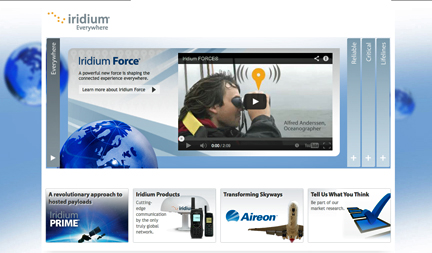[SatNews] Iridium Communications Inc. (Nasdaq: IRDM) has been awarded a $400 million, multi-year, fixed-price contract with the Defense Information Systems Agency (DISA) to provide satellite airtime services to meet the communications needs of the U.S. Department of Defense (DoD) and their federal partners.
This five-year contract renews the provision for delivering Enhanced Mobile Satellite Services (EMSS) airtime, effective October 22. Iridium will provide unlimited global secure and unsecure voice, low and high-speed data, paging and Distributed Tactical Communications System (DTCS) services for an unlimited number of DoD and other federal government subscribers.
The renewed EMSS contract extends the U.S. Government’s (USG) existing relationship with Iridium and ensures the continuation of service through new terms which offer program stability and the best value to the DoD to expand services supporting its critical missions. Both the multi-year and fixed-cost terms allow an even greater number of government subscribers to fully take advantage of the current capabilities as well as the enhanced services that will become available with Iridium NEXT—the Company’s next generation satellite constellation scheduled for first launch in early 2015—without concern for incremental cost increases based on usage changes or growth in demand. The Company’s U.S. Government service revenue for the full-year 2012 was $61.8 million. The EMSS fixed-price rate in each of the five contract years is $64 million in fiscal year (FY) 2014, $72 million in FY 2015 and $88 million in FY 2016, 2017, and 2018.
Scott Scheimreif, Iridium’s executive vice president, government programs, said, “We expect the DoD’s needs for satellite communication services will continue to grow over the next five to ten years. At a time when the U.S. Government is operating under greater fiscal constraints, Iridium is confident that both our service and contract terms will provide an optimal solution for our warfighters and other federal partners to communicate effectively now and in the future.”
In 2012, USG services and support made up 20 percent of Iridium’s revenues. USG subscribers on the Iridium network have grown from 32,000 to over 51,000 during the last five-year contract period as services grew from basic voice and paging, to data and Netted Iridium® with growing applications across all the services. According to the Defense Business Board fiscal year 2013 report to the Secretary of Defense, commercial satellite communications currently supports about 40 percent of the DoD’s satellite communication needs.
Northern Sky Research (NSR), a global leader providing satellite industry market research, predicts this requirement will grow by 68 percent over the next decade. The report concludes: “SATCOM is critical to supporting the warfighter, and DoD will require additional capacity in the future as new missions evolve and communication technologies further develop. To meet DoD’s needs, the commercial satellite sector is a cost-effective source for obtaining technologically advanced services.”
Iridium offers coverage anywhere in the world, including the polar regions. The Iridium NEXT program is a $3 billion investment to upgrade the network through the launch of 66 low-Earth orbiting (LEO) satellites, six in-orbit spares and nine ground spares, which will extend Iridium’s position as a critical communications provider by offering substantially greater bandwidth, improved data speeds and continued global coverage to more than 275 government and commercial partners and consumers. Iridium NEXT will also serve as a platform for Aireon(sm), a global aircraft-monitoring service using a space-based ADS-B hosted payload, as well as for the Company’s newly announced Iridium PRIME(sm) offering, a turnkey solution for hosted payloads which will service all elements of a successful hosted payload mission at an estimated cost savings of 50 percent or more compared to current stand-alone solutions.


